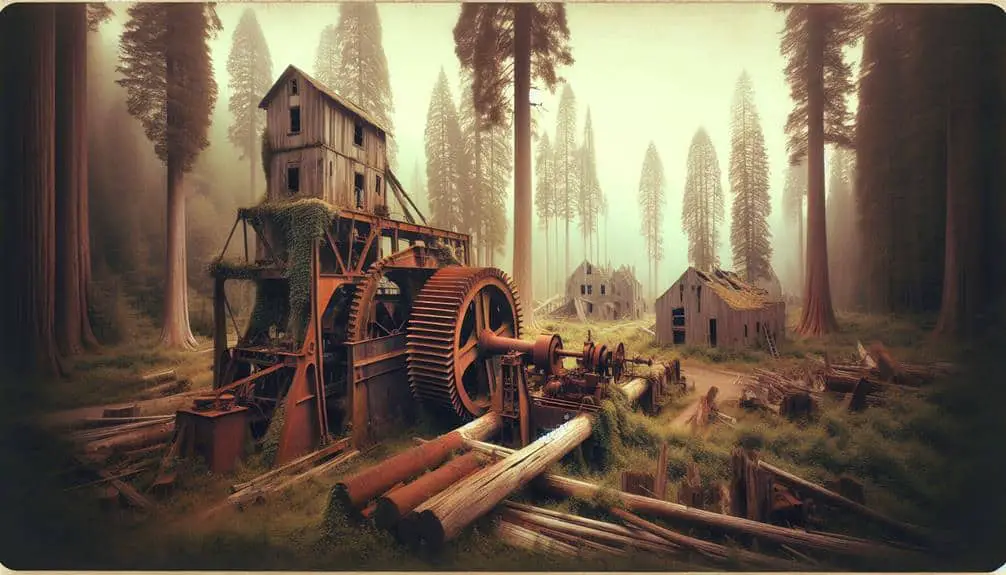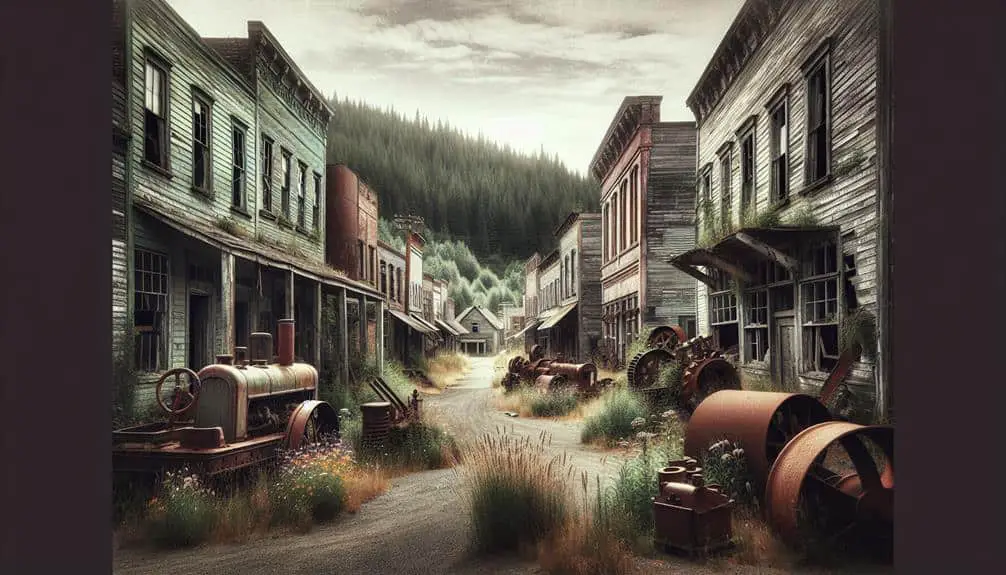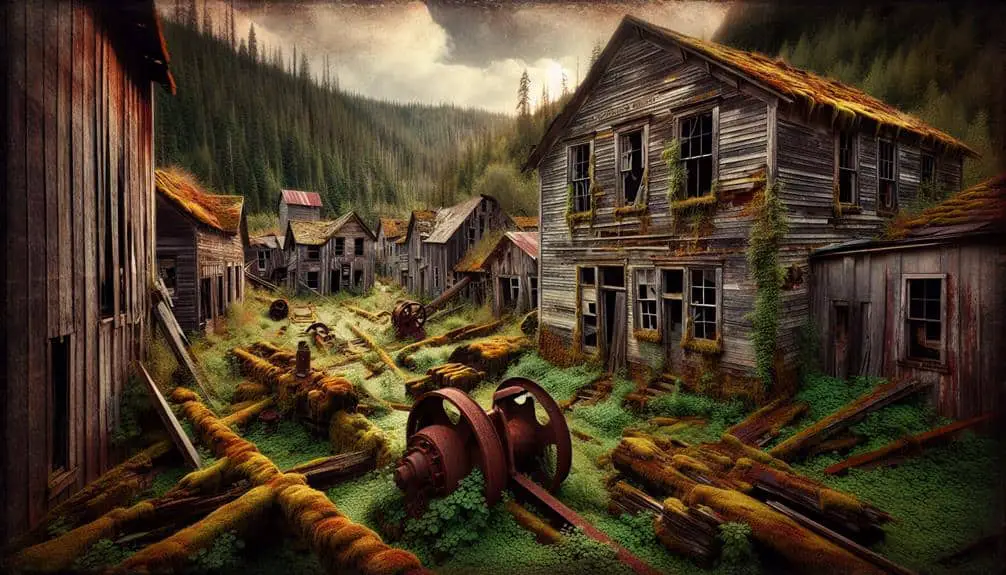Step into the haunting remnants of forgotten logging towns in America. Eagle Mills saw decline from shifting economics and logging tech. Mossyrock, once bustling, now echoes a bygone era. Lester weaves mining history with abandoned homes' tales. Aladdin, Wyoming, frozen in time, evokes nostalgia. Centralia's tragedy lies in a coal fire since 1962. Dive deeper into the rise and fall of these towns and the stories they silently hold.
Key Points
- Eagle Mills: Declined due to economic changes and logging technology advancements.
- Mossyrock: Once a bustling hub, now overgrown ruins of a bygone era.
- Lester: Abandoned homes reflect logging and mining history, nature reclaiming.
- Aladdin, Wyoming: Ghostly structures whisper tales of a forgotten past.
- Centralia: Infamous for coal fire since 1962, ongoing environmental impact and legal battles.
The Rise and Fall of Eagle Mills
Eagle Mills rose to prominence as a bustling logging town in the late 19th century, but its decline was swift and profound, leaving behind a haunting legacy of abandoned buildings and forgotten dreams. The industrial decline that befell Eagle Mills was a result of changing economic landscapes and advancements in logging technology that rendered the town's traditional methods obsolete. As the demand for timber dwindled, businesses closed, and residents sought opportunities elsewhere, ultimately leading to the town's abandonment.
Despite its desolate state, efforts towards historical preservation have emerged in recent years. Organizations and individuals have recognized the importance of Eagle Mills' history and have worked to document its past, advocate for its recognition, and preserve what remains of its cultural heritage. Through initiatives focused on maintaining the town's remaining structures and artifacts, there's a glimmer of hope that Eagle Mills' story won't fade into obscurity entirely.
Mossyrock: Once Vibrant, Now Silent
Once a bustling hub of activity, Mossyrock now stands as a silent reminder of a bygone era. The streets that were once filled with the sounds of bustling sawmills and lively conversations now echo only with the whispers of the wind through overgrown ruins. Mossyrock's transformation from a thriving logging town to a ghostly remains is a poignant reflection of the cyclical nature of industry and community.
The overgrown ruins of Mossyrock paint a vivid picture of abandonment and decay. Nature has reclaimed much of what was once built by human hands, with buildings now mere skeletons covered in moss and ivy. Walking through the deserted streets, one can't help but feel a sense of solemnity at the sight of what once was a vibrant town now frozen in time.
Despite its current state of desolation, Mossyrock serves as a powerful indicator of the transient nature of human endeavors. The ghostly remains of this once prosperous logging town stand as a proof to the impermanence of industry and the resilience of nature.
Echoes of Prosperity in Lester
The remnants of past prosperity linger in Lester, a manifestation of a bygone era of thriving logging activities in America. Once a bustling logging town, Lester now stands as a poignant reminder of the rise and fall of industries. As you explore this town frozen in time, you can't help but feel the echoes of its former glory.
- Mining History: Lester's roots are deeply intertwined with the mining industry, with many of its residents depending on the mines for their livelihood.
- Abandoned Homes: Empty houses line the streets, telling tales of families that once called this place home.
- Rustic Charm: Despite the economic decline, Lester exudes a rustic charm that draws visitors seeking a glimpse into the past.
- Nature's Reclamation: Nature has started to reclaim the town, with greenery peeking through cracks in the pavement.
- Community Spirit: Despite the challenges, a sense of community still lingers among the few remaining residents, a proof to the resilience of the human spirit.
Lost in Time: Aladdin, Wyoming
Nestled in the vast expanse of Wyoming lies Aladdin, a forgotten town frozen in time, its deserted streets whispering stories of a bygone era. As you explore Aladdin, you'll encounter ghostly structures that stand as silent witnesses to the town's rich but hidden history. The remnants of old buildings paint a picture of a bustling community that has long since vanished, leaving behind an eerie yet intriguing atmosphere.
Wandering through Aladdin, you may feel a sense of curiosity about the lives once lived in this now deserted place. The abandoned storefronts and empty houses evoke a nostalgic feeling, transporting you back to a time when this town was alive with activity. Despite its current state of decay, Aladdin holds a certain allure, drawing visitors who seek to uncover the secrets buried within its quiet streets.
In Aladdin, the past mingles with the present, offering a glimpse into a different era. The town's ghostly structures serve as reminders of a time when it was a thriving community, now frozen in time for curious souls to explore and unravel its hidden history.
Stark Reminder: Centralias Tragic Past
As you shift your focus from the abandoned logging town of Aladdin, Wyoming, the tragic past of Centralia emerges as a stark reminder of a community's devastating history. Centralia, Pennsylvania, once a bustling coal town, became infamous for a coal fire that has been burning beneath the ground since 1962. The town's plight serves as a cautionary tale of the long-lasting consequences of industrial accidents and environmental neglect.
- Underground Coal Fires: Centralia's coal fire, ignited in a landfill, has been burning for decades, rendering the town uninhabitable.
- Evacuation and Abandonment: Due to the toxic fumes and dangerous conditions caused by the fire, residents were forced to evacuate, and most buildings were demolished.
- Environmental Impact: The ongoing coal fire has resulted in significant environmental damage, polluting the air and soil in the area.
- Legal Battles: Centralia has been the center of legal battles, with the government trying to extinguish the fire while some residents fought to remain in their homes.
- Tourist Attraction: Despite its dangers, Centralia has become a curious tourist attraction, drawing visitors intrigued by the town's eerie, abandoned streets and the billowing smoke from below.
Frequently Asked Questions
What Caused the Decline of the Logging Industry in These Towns?
When the logging industry declined, it was like a once mighty oak slowly withering away. Economic downturns and environmental impacts led to population declines and infrastructure decay. The towns stood as reminders of a fading era.
Are There Any Efforts to Preserve the Historical Buildings or Landmarks in These Abandoned Towns?
Preservation efforts in abandoned towns involve restoring historical landmarks, fostering community revitalization, and boosting economic development. By preserving the past, these towns can create a brighter future for residents and visitors alike.
How Did the Residents of These Towns Cope With the Economic Downturn After the Logging Industry Collapsed?
During the economic downturn post-logging collapse, residents in these towns faced severe economic struggles. However, strong community support emerged, aiding in coping with challenges. This unity helped cushion the impact of the industry's decline.
Are There Any Ghost Stories or Legends Associated With These Abandoned Logging Towns?
Do you ever wonder about the eerie whispers of haunted tales that linger in the forgotten corners of abandoned towns? Ghostly folklore tells of mysterious disappearances and supernatural encounters, shrouding these places in a chilling aura.
What Impact Did the Closure of the Logging Industry Have on the Surrounding Environment and Wildlife in These Towns?
When the logging industry shut down, the closure had a substantial impact on ecosystems. Wildlife conservation efforts became essential in these areas to help preserve habitats and protect the diverse species that called these towns home.



